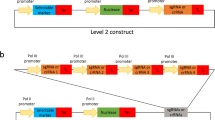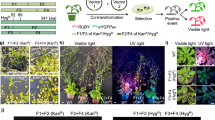Abstract
We present a series of 14 binary vectors suitable for Agrobacterium-mediated transformation of dicotyledonous plants and adaptable for biolistic transformation of monocotyledonous plants. The vector size has been minimized by eliminating all non-essential elements from the vector backbone and T-DNA regions while maintaining the ability to replicate independently. The smallest of the vector series is 6.3 kb and possesses an extensive multiple cloning site with 21 unique restriction endonuclease sites that are compatible with common cloning, protein expression, yeast two-hybrid and other binary vectors. The T-DNA region was engineered using a synthetic designer oligonucleotide resulting in an entirely modular system whereby any vector element can be independently exchanged. The high copy number ColE1 origin of replication has been included to enhance plasmid yield in Escherichia coli. FRT recombination sites flank the selectable marker cassette regions and allow for in planta excision by FLP recombinase. The pORE series consists of three basic types; an ‘open’ set for general plant transformation, a ‘reporter’ set for promoter analysis and an ‘expression’ set for constitutive expression of transgenes. The sets comprise various combinations of promoters (P HPL, P ENTCUP2 and P TAPADH), selectable markers (nptII and pat) and reporter genes (gusA and smgfp).


Similar content being viewed by others
Abbreviations
- bp:
-
Base pair
- DNA:
-
Deoxyribonucleic acid
- dsDNA:
-
Double stranded DNA
- gusA :
-
β-Glucuronidase
- LB:
-
Left T-DNA border
- MCS:
-
Multiple cloning site
- nptII:
-
Neomycin phosphotransferase II
- OxOx:
-
Oxalate oxidase
- pat :
-
Phosphinothricin acetyltransferase
- P ENTCUP2 :
-
Tobacco cryptic constitutive promoter
- PCR:
-
Polymerase chain reaction
- P HPL :
-
Arabidopsis thaliana hydroperoxide lyase promoter
- P TAP :
-
Triticum aestivum lipid transfer protein promoter
- P TAPADH :
-
Triticum aestivum lipid transfer protein promoter fused to an alcohol dehydrogenase intron
- RB:
-
Right T-DNA border
- SDM:
-
Site directed mutagenesis
- smgfp :
-
soluble modified green fluorescent protein
- T-DNA:
-
Transferred DNA
- Ti:
-
Tumour inducing
- T NOS :
-
Polyadenylation signal from the nopaline synthase gene
- Vir :
-
Virulence region of the Ti plasmid
References
Azam N, Dixon JE, Sadowski PD (1997) Topological analysis of the role of homology in flp-mediated recombination. J Biol Chem 272:8731–8738
Bate NJ, Sivasankar S, Moxon C, Riley JM, Thompson JE, Rothstein SJ (1998) Molecular characterization of an Arabidopsis gene encoding hydroperoxide lyase, a cytochrome P-450 that is wound inducible. Plant Physiol 117:1393–1400
Bechtold N, Ellis J, Pelletier G (1993). In planta Agrobacterium mediated gene transfer by infiltration of adult Arabidopsis thalianai plants. C R Acad Sci Paris Life Sci 316:1194–1199
Clough S, Bent A (1998) Floral Dip: a simplified method for Agrobacterium-mediated transformation of Arabidopsis thaliana. Plant J 16:735–743
Davis SJ, Vierstra RD (1998) Soluble, highly fluorescent variants of green fluorescent protein (gfp) for use in higher plants. Plant Mol Biol 36:521–528
Gelvin S (2000). Agrobacterium and plant genes involved in T-DNA transfer and integration. Ann Rev Plant Physiol Plant Mole Biol 51:223–256
Gelvin S (2003) Agrobacterium-mediated plant transformation: the biology behind the “gene-jockeying” tool. Microbiol Mol Biol Rev 67:16–37
Gidoni D, Bar M, Leshem B, Gilboa N, Mett A, Feiler J (2001) Embryonal recombination and germline inheritance of recombined Frt loci mediated by constitutively expressed Flp in tobacco. Euphyti J 121:145–156
Goderis IJ, De Bolle MF, Francois IE, Wouters PF, Broekaert WF, Cammue BP (2002) A set of modular plant transformation vectors allowing flexible insertion of up to six expression units. Plant Mol Biol 50:17–27
Helens RP, Edwards EA, Leyland NR, Bean S, Mullineaux PM (2000) pGreen: a versatile and flexible binary Ti vector for Agrobacterium-mediated plant transformation. Plant Mol Biol 42:819–832
Kim SR, Lee J, Jun SH, Park S, Kang HG, Kwon S, An G (2003) Transgene structures in T-DNA-inserted rice plants. Plant Mol Biol 52:761–773
Luo H, Kausch AP (2002) Application of FLP/FRT site-specific DNA recombination system in plants. Genet Eng 24:1–16
Luo H, Lyznik LA, Gidoni D, Hodges TK (2000) Flp-mediated recombination for use in hybrid plant production. Plant J 23:423–430
Malik K, Wu K, Li XQ, Martin-Heller T, Hu M, Foster E, Tian L, Wang C, Ward K, Jordan M, Brown D, Gleddie S, Simmonds D, Zheng S, Simmonds J, Miki B (2002) A constitutive gene expression system derived from the Tcup cryptic promoter elements. Theor Appl Genet 105:505–514
McCormac AC, Elliott MC, Chen DF (1997) pBecks: a plexible series of binary vectors for Agrobacterium-mediated plant transformation. Mol Biotechnol 8:199–213
Nakamura Y, Gojobori T, Ikemura T (2000) Codon usage tabulated from the international DNA sequence databases: status for the Year 2000. Nucleic Acids Res 2000:292
Sambrook J, Russell D (2001) Molecular cloning: a laboratory manual. Cold Spring Harbour Laboratory Press, New York
Schafer U, Hegedus D, Bate NJ, Gleddie S, Brown DC (2002) Hydrogen peroxide lyase regulatory region. International Patent WO 2002/050291
Sheng J, Citovsky V (1996) Agrobacterium-plant cell DNA transport: have virulence proteins, will travel. Plant Cell 8:1699–1710
Simmonds J, Leslie C, Harris L, Sharon A (2001) Wheat aleurone regulatory region. US Patent 6:326–528
Wu K, Malik K, Tian L, Hu M, Martin T, Foster E, Brown D, Miki B (2001) Enhancers and core promoter elements are essential for the activity of a cryptic gene activation sequence from tobacco, Tcup. Mol Gen Genet 265:763–770
Xiang C, Han P, Lutziger I, Wang K, Oliver DJ (1999) A mini binary vector series for plant transformation. Plant Mol Biol 40:711–717
Yenofsky R, Fine M, Pellew J (1990) A mutant neomycin phosphotransferase II gene reduces the resistance of transformants to antibiotic selection pressure. Proc Natl Acad Sci USA 87:3435–3439
Acknowledgments
This research was made possible with funds from the Agriculture and Agri-Food Canada Crop Genomics Initiative
Author information
Authors and Affiliations
Corresponding author
Rights and permissions
About this article
Cite this article
Coutu, C., Brandle, J., Brown, D. et al. pORE: a modular binary vector series suited for both monocot and dicot plant transformation. Transgenic Res 16, 771–781 (2007). https://doi.org/10.1007/s11248-007-9066-2
Received:
Accepted:
Published:
Issue Date:
DOI: https://doi.org/10.1007/s11248-007-9066-2




